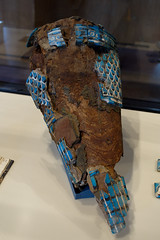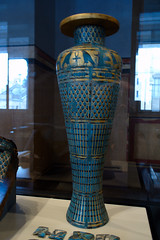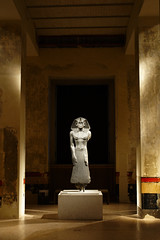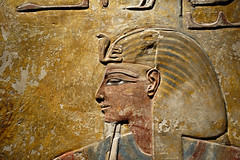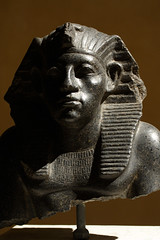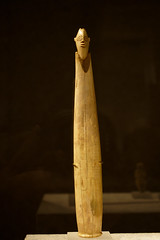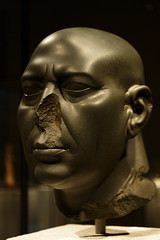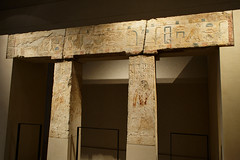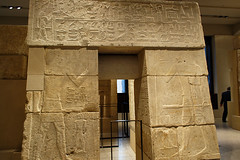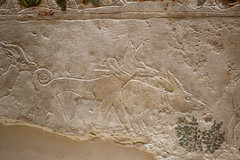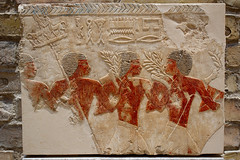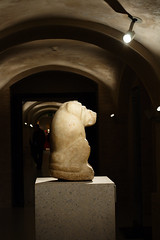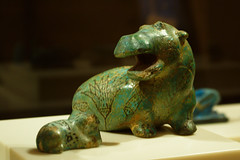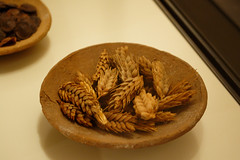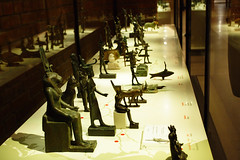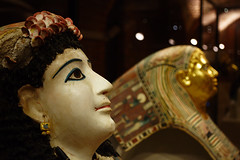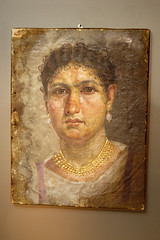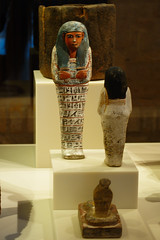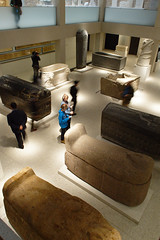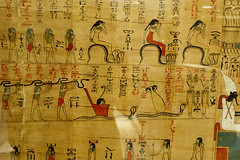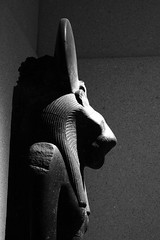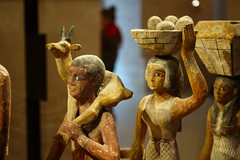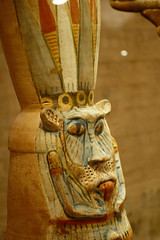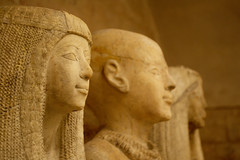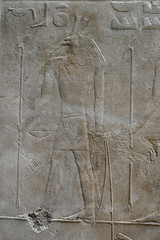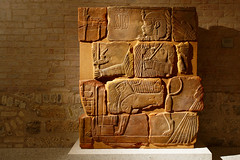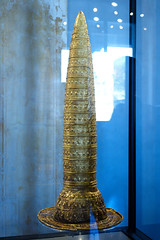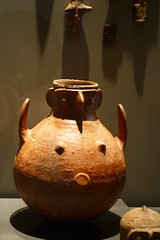As well as the Amarna exhibition (post) J and I spent quite a lot more time in the rest of the Egyptian collections in the Neues Museum. Where we could take photos, and I did – you can find them on flickr and some highlights in this post.
Floor 1 (Ground Floor)
As you go into the museum the Egyptian collections start on the right hand side with a room they title “Prologue” that covers where they got their material – i.e. the German excavations in Egypt. I’m not, as it happens, particularly interested in 19th Century colonial behaviour by the European nations so I was more looking at the various objects in their own right. Notably this room had some of the original ceilings of the museum, which are painted blue with gold Egyptian style decoration. I particularly liked a pair of objects where they had the vase they discovered & a replica to show you what it looked like:
The next room is called Pharaoh, and is filled with images of the Pharaoh as King (plus one image of a queen, Ahmose-Nefertari). I was particularly fond of the bit of decoration they had from the tomb of Seti I.
From here you go to a room that has a chronological arrangement of thirty centuries of sculptures of humans. Most of these are disembodied heads, and you can see how the style is both the same & different for most of the history of Egypt and the pre-Dynastic item is strikingly different.
In the next room there are three tomb chapels, and assorted other reliefs & statues associate with tombs. The three chapels are fairly substantial, and date from the Old Kingdom era. Particularly striking was the one that hadn’t been finished – there are still the black outline drawings where the carver is to carve the relief in some sections.
The last room on this floor is a balcony around the room on Floor 0 which houses the sarcophagi so you can see the decoration on the lids. There are also several pieces from reliefs around the sides, with a general theme of fertility & nature, and farming & animal husbandry.
Floor 2 (1st Floor)
Upstairs would normally house the New Kingdom & Amarna era stuff, along with a room labelled sculpture. When we went this was completely taken over by the Amarna Exhibition (post) which I couldn’t take photos in.
The only rooms in their normal state were the Nefertiti room and the Library of Antiquity (neither of which permitted photography). The Library of Antiquity was a room full of papyri ranging in date from the Old Kingdom (c.2500BC) through to Arabic texts early after the Islamic conquest of Egypt. They were displayed in large cabinets which had motorised drawers – normally all drawers were shut protecting the papyri but when you pressed the button the drawer slid out so you could see the documents. All completely incomprehensible to me, as they were in hieroglyphs, hieratic, demotic, coptic & arabic scripts. I think my favourite was one from the Old Kingdom – a 6th Dynasty letter of complaint about non-payment for a grain shipment, a reminder that the concerns of people then were very similar to the concerns of people now.
Floor 0 (Basement)
Downstairs there were several more rooms full of Egyptian objects. I may have the boundary between the first two rooms incorrect in my sets of photos or in my notes, but definitely first there were a selection of general objects with a theme of the habitat of the Nile Valley. And a very striking baboon statue dating from the time of Narmer (the unifier of Egypt, c.f. the Narmer Palette in the Egyptian Museum in Cairo).
The next room is just labelled “Egypt” on the floor plan, and it had three different sorts of object. One was a selection of small statues of the gods of Egypt laid out on a map of the Nile according to the cult centres, and another case of them sorted by types. There were also representations of animals and crops (possibly these were actually in the room before, my notes aren’t clear). And at the end of the room were some rather fine mummy masks, and somewhat less impressive coffins.
The next room was my favourite – called “Afterworld”. The central case had a selection of box coffins and mummiform coffins, and grave goods. Around the sides were shabti, canopic jars & some animal mummies. They also had a Roman period mummy portrait.
Next on the agenda was “Journey to the Netherworld” – a room full of sarcophagi. Plus an interloper prehistoric German tomb, rather oddly. Round the walls there were various of the books of the afterlife, including a selection of Books of the Dead. Because you could see down from the balcony above it meant I got to see the lids which are normally above my eye-level 🙂 And this was the room where they had their Sekhmets!
The next room was about Everyday Life, and was mostly filled with objects from tombs as these can be some of the best preserved examples of everyday objects. There were some particularly fine offering bearers from a Middle Kingdom tomb, as well as other models of servants, pottery, musical instruments, games & toys, jewellery etc etc. There were also a selection of statues of family groups.
That’s the end of the truly Egyptian themed rooms. There were another couple of rooms with Egyptian or Egyptian influenced stuff in, however. One of these was the Greek Courtyard, which actually had several Old Kingdom reliefs spaced out around the room.
And lastly there was a room of Nubian artifacts. At times Nubia (modern-day Sudan) was ruled by Egypt, at times they ruled Egypt, there was always some cross-fertilisation of culture. There were several reliefs which look almost Egyptian but not quite, and pottery from various eras of Nubian history. I was particularly struck by a carved base for a barque which has the names of the King & his Queen in both Merotic & hieroglyphic script – this has been a great help for the deciphering of Merotic script. Unfortunately as it’s just names it hasn’t really helped in deciphering the language.
Non-Egyptian Stuff
What I’ve talked about above is approximately half the contents of the museum, the rest is non-Egyptian antiquities including Schliemann’s excavation of Troy. There’s also a section on the history of the museum, with photos from before & after it was bombed and discussion of the many artifacts that were taken back to Russia by the Red Army & never returned. I spent only about an hour quickly looking at a few bits & pieces here, so not many photos nor notes on what I saw.
I’m pretty sure J read somewhere before we went that “there’s not that big a collection of Egyptian stuff in Berlin”, but I’ve no idea why someone would say that – there’s really quite a lot. Worth a visit 🙂
